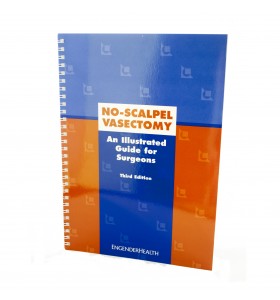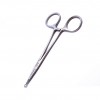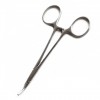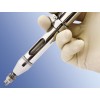|
 |
|
|
|
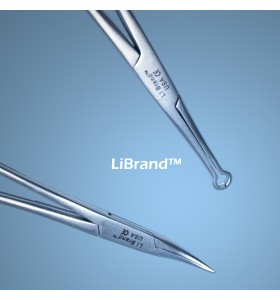 |
The Vasectomy Store - A Comparison of Vasectomy Ringed Forceps
Q: I notice that you offer different types of ringed forceps. When would one use the non-cantilevered versus the cantilevered ringed forceps? What does the term “cantilever” mean?
A: We offer various types of ringed forceps—cantilevered, non-cantilevered small, and non-cantilevered teardrop because our clients ask for them. Each of these instruments has its advantages and drawbacks, depending on the techniques used by the physician. Based on our experience with thousands of vasectomist clients, below is a discussion of each type of forceps and why practitioners tend to choose them.
The Standard Cantilevered Ringed Forceps 
Our most popular ringed forceps is the standard cantilevered ringed forceps. The term cantilever refers to the anti-lever action of the instrument. With most instruments, a scissors or standard Kelly, for instance, the more you close it, the greater the pressure exerted at the tips. With our Li Brand(TM) cantilevered ringed forceps, however, pressure at the tips only increases until the instrument is locked. After that, closing the instrument more actually causes the tips of the instrument to come apart, ever so gently, so that less pressure, not more, is exerted at the tips. Many companies have tried to copy this cantilever, but it is very difficult to produce well.
According to Dr. Li Shunqiang, inventor of the No-Scalpel Vasectomy, the major reason for NSV’s documented 10-fold reduction in complications, especially bleeding, is the cantilever on the ringed forceps. This cantilever allows the forceps to hold the vas firmly in place without pinching or crushing the highly delicate structures both in and around the vas. In particular, lower pressure at the tips helps protect the vas artery, which runs directly beneath the vas.
Having the scrotal skin stretched tightly around the vas is also vitally important to a good no-scalpel vasectomy. If the vas is not fixed in place or is loose within the ring, the vas can ‘swim’ left or right during the procedure, rendering the surgical approach inaccurate and leading to inferior results.
For most European and North American male vasa, the standard ring size for 95% of procedures is the 3.5mm VE-1. There are exceptions, but unless you serve an exceptionally corpulent male population with tight scrotums, the 3.5mm is the best size for you. In some cases, it may be useful to have a 4.0mm ringed forceps on hand for use with tougher cases, but larger than 4.0 and the vas may start to ‘swim’ from side to side inside the ring.
The Non-Cantilevered, Small Ringed Forceps 
The second most popular ringed forceps is a non-cantilevered, slightly smaller ringed forceps. These have a ring diameter of approximately 3.0mm. Most practitioners who prefer this instrument tell us that they are not performing a standard NSV approach. Instead, they are creating a small entry using a scalpel or hemostat, then reaching into the scrotum with the instrument, grasping around the vas, and pulling it out through the opening. Using this forceps the risk of bleeding is much higher than with the standard cantilevered forceps, but delivery can be easier than with standard NSV technique. If the practitioner is reaching into the scrotum to find and deliver the vasa in this way, the smaller ring is much easier to insert into the scrotal opening.
The Non-Cantilevered ‘Teardrop’ Ringed Forceps 
The most recent forceps to be adopted for use with vasectomy in the United States is the teardrop, non-cantilevered forceps. When NSV was first introduced to the U.S. in the mid-1980s, access to instruments was initially limited to urologists who had received hands-on training. The teardrop forceps was developed by a family physician who wanted to perform a ‘no-scalpel’ procedure but couldn’t get the instruments.
The teardrop forceps has a ring that is much larger than those of other forceps. Some practitioners have told us that it can be a very effective training instrument because it is much easier to grasp the vas, especially for those new to NSV. With more practice, the advantage of a large ring usually diminishes. Since the teardrop shape is too large to stretch the scrotal skin tightly over the vas and the vas can shift from side to side, it can be difficult to make consistent entry punctures in the center of the vas. Like other non-cantilevered forceps, the risk of bleeding is higher than with the standard NSV ringed forceps.


